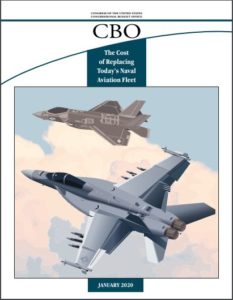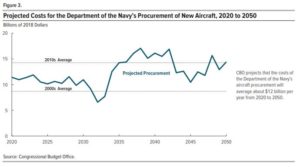A new Congressional Budget Office (CBO) report estimated it will cost the Department of the Navy about $380 billion to maintain the current size of the Navy and Marine Corps aviation fleet through 2050.
The report, The Cost of Replacing Today’s Naval Aviation Fleet, released Monday, estimates that buying new aircraft to maintain the current naval aviation force size will cost about $11 billion per year through 2030. CBO said this is “an amount similar to the average since 2000.”

Thereafter, costs will drop temporarily as large programs like the MV-22B tiltrotor, CH-53K helicopter, and F-35B/C fighters start to wind down or end, marking “the completion of a nearly total replacement of the fleet over the past 30 years.”
This translates into an expected cost of $7 billion in annual aircraft procurement from 2030-2032, largely due to the planned end of planned purchases of the F-35B and C fighters and CH-53K helicopters.
“The end of the 2020s roughly corresponds to the end of a 30-year cycle during which the Navy and Marine Corps have replaced nearly their entire aircraft fleet,” the report said.
Then, by the mid-2030s, costs would rise to about $14 billion annually from 2034 to 2050 as the next replacement cycle starts. CBO projects this to include the first purchases of aircraft to replace the F/A-18 E/F Super Hornet and EA-18G Growlers and early production MC-22Bs.
The high is expected to reach about $17 billion in aircraft procurement by 2038 before averaging closer to $16 billion from 2038 to 2042. Thereafter, costs would lower to about $13 billion per year from 2043 to 2050.
Combining the periods leads to an average of $12 billion per year from 2020 to 2050.
In analyzing the costs, CBO noted the Navy Department’s current aviation fleet has 4,000 aircraft and is divided into about 1,400 fixed-wing fighters/attack aircraft, 1,350 helicopters/tiltrotors, and 750 trainers. The other roughly 500 are surveillance, communication, cargo, and utility aircraft.
CBO disclosed that as of June 2018 the Navy and Marine Corps have 471 F/A-18 A-D Hornets, 545 F/A-18E/F Super Hornets, 152 EA-18G Growlers , and 85 F-35B/C Lighting IIs. The helicopters and tiltrotors were divided into 94 AH-1Z Viper attack helicopters, 142 CH-53E Super Stallion heavy-lift helicopters, 529 MH-60R/S Sea Hawks, 288 MC-22B Osprey tiltrotors, and 149 UH=-1Y Venom light lift and light attack helicopters.
The service also had 72 E-C2C/D Hawkeyes, 77 P-8A Poseidons, and 4 MQ-4C Tritons as surveillance and communication vehicles; 207 fixed-wing transport and aerial refueling aircraft; and 753 trainer and adversary fixed-wing and helicopter aircraft.
Nearly half of the current fleet was acquired or remanufactured within the last 10 years, but fixed-wing transports, aerial refuelers, and trainer/adversary aircraft are on average the oldest.

The report said it assumed the Navy will implement currently planned aircraft procurement programs and replace aircraft at the end of their typical service life even if there are no specific plans to do so yet.
The CBO noted like for any long-term projection, these estimates are limited by uncertainty to changes of the size and composition of the aviation forces due to technology, budget constraints, or changes in the national security situation.
Many fighters and attack vehicles have been replaced in the last years or are planned to be in the next years and thus are not planned to be replaced again until the latter part of the 30-year projection.
The costliest types if aircraft procurements through 2050 are fighter/attack aircraft and the Marine Corps’ combat rotorcrafts, which combined make up over 80 percent of the projected costs, CBO said.
“Just the top five most expensive systems (which are in the same categories) account for more than 60 percent of total projected aircraft procurement costs,” the report continued.
The CBO noted alternative options to several expected replacements, some which may save money and others that could increase costs.
For example, the Navy plans to develop a new aircraft, the FA-XX, to replace its Super Hornets that will reach the end of their service life starting in the mid-2030s. If production starts in 2032, it is projected to cost $67 billion for the first 448 aircraft bought through 2050. CBO assumed the FA-XX will have “substantial improvements over the F-35C.”
However, if the Navy instead merely bought more F-35Cs to replace the Super Hornets, it would cost $50 billion.
In contrast, CBO said according to the December 2018 Selected Acquisition Reports, procurement costs for the CH-53K from 2020 to 2028 will reach $19 billion. Thereafter, a replacement is expected in the mid-2040s.
The report said it projects $10 billion spent from 2042 to 2050 for the first 85 CH-53K replacements, assuming the new aircraft is similar. However, if the Marine Corps decided on a new heavy-lift aircraft with the speed of the MV-22B or something based on AH-1Z and UH-1Y replacements themselves based on the Army’s Future Long-Range Assault Aircraft, costs would likely be “substantially higher.”